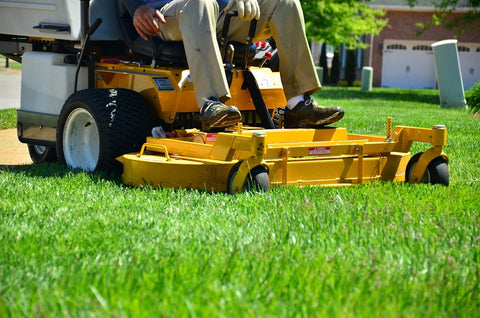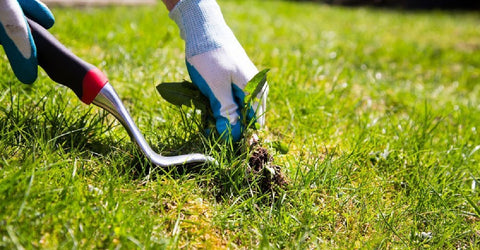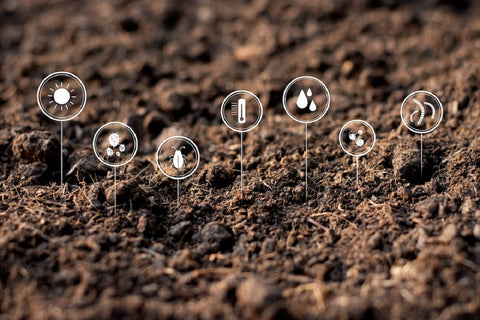A lush, green lawn can transform your home's curb appeal and provide a welcoming outdoor space for your family and friends. Achieving and maintaining a beautiful lawn requires proper care and attention throughout the year. In this comprehensive guide to lawn care management, we'll walk you through the essential steps and best practices to ensure your lawn is the envy of the neighborhood.
Understanding Your Lawn
Before diving into lawn care, it's crucial to understand your lawn's unique characteristics. Consider factors such as your grass type, soil type, climate, and sun exposure. Different grass varieties have different needs, and tailoring your care routine to your specific lawn type will yield the best results.
Regular Mowing
Mowing is a fundamental aspect of lawn care. Follow these guidelines for optimal mowing practices:
Set the mower blade at the appropriate height for your grass type. Taller grass shades the soil, reducing weed growth and promoting healthier roots.
Never cut more than one-third of the grass blade's height in a single mowing.
Keep your mower blade sharp to ensure a clean cut and prevent grass damage.

Proper Watering
Watering is essential for a thriving lawn, but it's crucial to do it correctly. Here's how to water your lawn effectively:
Water deeply and infrequently to encourage deep root growth. Aim for about 1-1.5 inches of water per week, including rainfall.
Water early in the morning to minimize evaporation and reduce the risk of fungal diseases.
Use a sprinkler system or hose with a sprinkler attachment to ensure even coverage.
Fertilization
The best fertilizer for your lawn will depend on a number of factors, including the type of grass you have, the climate you live in, and the condition of your lawn. However, there are a few general tips that can help you choose the right fertilizer:
- Look for a fertilizer with a balanced N-P-K ratio. N-P-K stands for nitrogen, phosphorus, and potassium, which are the three essential nutrients that lawns need. Most lawn fertilizers will have a ratio of 3:1:2 or 4:1:2.
- Choose a slow-release fertilizer. Slow-release fertilizers release nutrients gradually over time, which helps to prevent nutrient burn and promote even growth.
- Consider using an organic fertilizer. Organic fertilizers are made from natural materials, such as manure and compost. They are a good option for homeowners who want to avoid using synthetic chemicals.
Here are a few specific fertilizer recommendations:
- Milorganite Slow Release Nitrogen Lawn Fertilizer is a good all-purpose fertilizer for lawns. It is a slow-release fertilizer with a balanced N-P-K ratio.
- Jonathan Green Winter Survival Fall Fertilizer is a good fertilizer for lawns in cold climates. It helps to protect lawns from winter damage.
- GreenView Lawn Food is a good fertilizer for lawns that need a quick boost of nutrients. It is a fast-release fertilizer with a high nitrogen content.
- Scotts Natural Lawn Food is a good option for homeowners who want to use an organic fertilizer. It is made from natural materials, such as manure and compost.
When choosing a fertilizer, be sure to read the label carefully and follow the instructions. Over-fertilizing can damage your lawn.
Weed Control
Weeds can quickly invade and detract from your lawn's beauty. Implement these weed control strategies:
There are two main types of weed ridders: pre-emergent herbicides and post-emergent herbicides.
Pre-emergent herbicides are applied to the soil before weeds have a chance to germinate. They work by creating a barrier that prevents weed seeds from sprouting. Pre-emergent herbicides are typically applied in the spring and fall.
Post-emergent herbicides are applied to weeds that have already emerged. They work by killing the weeds or preventing them from growing. Post-emergent herbicides can be applied at any time of year, but they are most effective when applied to young, actively growing weeds. Spot-treat weeds with post-emergent herbicides or manually remove them.

Here are some recommended weed ridders:
Pre-emergent herbicides:
- Non-Selective Pre-emergent herbicides
Oryzalin, Pendimethalin, Siduron, Barricade, Preen
- Selective Pre-emergent herbicides
- Dithiopyr is a selective pre-emergent herbicide that is effective against a wide range of broadleaf weeds, such as crabgrass, dandelions, and clover. It is also effective against some grassy weeds, such as foxtails and poa annua.
- Isoxaben is a selective pre-emergent herbicide that is effective against a wide range of broadleaf weeds, such as crabgrass, dandelions, and clover. It is also effective against some grassy weeds, such as foxtails and ryegrass.
- Prodiamine is a selective pre-emergent herbicide that is effective against a wide range of broadleaf and grassy weeds. It is commonly used on lawns, golf courses, and other areas where turfgrass is grown.
Post-emergent herbicides:
- Non-Selective Post-emergent herbicides
Glyphosate, Glufosinate, Diquat, Paraquat
- Selective Post-emergent herbicides
- Triclopyr is a selective herbicide that is effective against a wide range of broadleaf weeds, such as clover, dandelions, and chickweed. It is also effective against some woody plants, such as brush and trees.
- 2,4-D is a selective herbicide that is effective against a wide range of broadleaf weeds, such as dandelions, clover, and chickweed. It is not effective against grassy weeds.
- MCPP is a selective herbicide that is effective against a wide range of broadleaf weeds, such as dandelions, clover, and chickweed. It is not effective against grassy weeds.
- Dicamba is a selective herbicide that is effective against a wide range of broadleaf weeds, such as dandelions, clover, and chickweed. It is also effective against some woody plants, such as brush and trees.
- Clopyralid is a selective herbicide that is effective against a wide range of broadleaf weeds, such as clover, dandelions, and chickweed. It is also effective against some woody plants, such as brush and trees.
Here is a more detailed breakdown of when to apply pre-emergent and post-emergent herbicides, based on climate:
Cool-season climates:
- Pre-emergent herbicides: Early spring and early fall
- Post-emergent herbicides: Spring and fall
Warm-season climates:
- Pre-emergent herbicides: Late spring and early fall
- Post-emergent herbicides: Spring and summer
It is important to note that all herbicides, whether selective or non-selective, can be harmful to humans and the environment if used incorrectly. Be sure to read the label carefully and follow the instructions when using herbicides.
Non-selective post-emergent herbicides should only be used as a last resort. They can kill all plants, including desirable plants such as flowers, shrubs, and trees. If possible, it is better to use selective herbicides to control specific weeds.
If you are unsure which non-selective post-emergent herbicide is right for your needs, or how to use it safely, you can consult with a local lawn care professional.
Aeration
Lawn aeration involves perforating the soil with holes to allow air, water, and nutrients to penetrate deeply. This process can relieve soil compaction and improve root growth. Aerate your lawn once a year, preferably in the fall or spring.

Pest and Disease Management
Keep an eye out for signs of pests and diseases. Promptly address issues such as grubs, chinch bugs, and fungal diseases with appropriate treatments.
The recommended pesticides for lawn care will depend on the type of pests you are trying to control.
Here are some general recommendations:
- Grubs: Apply a grub control insecticide in the spring or fall, when the grubs are actively feeding.
- Chinch bugs: Apply a chinch bug control insecticide in the summer, when the chinch bugs are most active.
- Armyworms: Apply an armyworm control insecticide in the spring or fall, when the armyworms are most active.
- Fleas: Apply a flea control insecticide in the spring and summer, when the fleas are most active.
- Ticks: Apply a tick control insecticide in the spring and summer, when the ticks are most active.
It is important to note that all pesticides can be harmful to humans and the environment if used incorrectly. Be sure to read the label carefully and follow the instructions when using pesticides.
Here is a more detailed breakdown of when to apply pesticides for common lawn pests:
|
Pest
|
Application Time
|
|
Grubs
|
Spring or Fall
|
|
Chinch bugs
|
Summer
|
|
Armyworms
|
Spring or Fall
|
|
Fleas
|
Spring and Summer
|
|
Ticks
|
Spring and Summer
|
Fungal diseases can emerge in lawns under a variety of conditions, but some of the most common triggers include:
- Warm, humid weather: Many fungal diseases thrive in warm, humid conditions. This is because the heat and humidity provide an ideal environment for fungal spores to germinate and grow.
- Cool, wet weather: Some fungal diseases, such as dollar spot, are more common during cool, wet weather. This is because the cool temperatures and wet conditions slow down the growth of the grass, making it more susceptible to fungal infection.
- Overwatering: Overwatering can create the ideal conditions for fungal diseases to develop. This is because the excess water provides a moist environment for fungal spores to germinate and grow.
- Poor drainage: Poor drainage can also contribute to the development of fungal diseases. This is because the standing water can create a moist environment for fungal spores to germinate and grow.
- Stress: Lawns that are stressed due to drought, heat, or other factors are more susceptible to fungal infection.

In addition to these general conditions, some fungal diseases are also more likely to emerge in certain types of lawns. For example, fairy rings are more common in lawns that are high in organic matter.
If you notice any signs of fungal disease in your lawn, it is important to take action immediately to prevent the disease from spreading. This may involve applying a fungicide, removing any dead or diseased grass, and improving the drainage of your lawn.
Here are some of the most common fungal diseases found in lawns:
- Brown patch is a fungal disease that causes round or irregular patches of brown grass to appear in the lawn. It is most common during hot, humid weather.
- Dollar spot is a fungal disease that causes small, round patches of dead grass to appear in the lawn. It is most common during cool, wet weather.
- Fairy ring is a fungal disease that causes rings of mushrooms to appear in the lawn. The grass inside the ring may be brown and dead, or it may be greener than the surrounding grass.
- Gray leaf spot is a fungal disease that causes gray spots on the leaves of grass. It is most common during cool, wet weather.
- Rust is a fungal disease that causes orange or brown rust-colored spots to appear on the leaves of grass. It is most common during warm, humid weather.
Here are some recommended fungicides for each of these diseases:
- Brown patch: Propiconazole, azoxystrobin, thiophanate methyl
- Dollar spot: Propiconazole, azoxystrobin, pyraclostrobin, triadimefon
- Fairy ring: Propiconazole, azoxystrobin, triadimefon, tebuconazole
- Gray leaf spot: Propiconazole, azoxystrobin, thiophanate methyl
- Rust: Propiconazole, azoxystrobin, pyraclostrobin, triadimefon
It is important to note that all fungicides can be harmful to humans and the environment if used incorrectly. Be sure to read the label carefully and follow the instructions when using fungicides.
Here are some additional tips for preventing and treating fungal diseases in lawns:
- Keep your lawn healthy and well-maintained. A healthy lawn is less susceptible to fungal diseases.
- Water your lawn deeply and less often. This will help to promote deep root growth and make the lawn more drought-tolerant.
- Avoid over-fertilizing your lawn. Over-fertilizing can promote the growth of fungi.
- Remove any dead or diseased grass from your lawn. This will help to prevent the spread of fungal diseases.
- Apply a fungicide to your lawn in the spring and fall, as a preventive measure.
- Apply a fungicide to your lawn immediately if you see any signs of fungal disease.
By following these tips, you can help to prevent and treat fungal diseases in your lawn.
Overseeding and Reseeding
To fill in thin or bare patches in your lawn, consider overseeding or reseeding:
Overseeding involves spreading grass seed over the existing lawn to thicken the turf.
Reseeding is the process of seeding bare areas to establish new grass growth.
Harnessing the Power of Soil Microbes for a Beautiful Lawn
Applying soil microbes to lawns can help to keep them healthy. Soil microbes are tiny organisms that live in the soil and play an important role in plant health. They help to break down organic matter, release nutrients, and protect plants from pests and diseases.

Here are some of the benefits of applying soil microbes to lawns:
- Improved soil health: Soil microbes help to improve soil structure, drainage, and fertility.
- Increased nutrient uptake: Soil microbes help plants to absorb nutrients from the soil more efficiently.
- Improved pest and disease resistance: Soil microbes can help to protect lawns from pests and diseases by competing with them for resources and by producing antibiotic compounds.
- Reduced need for fertilizers and pesticides: Soil microbes can help to reduce the need for fertilizers and pesticides by making nutrients more available to plants and by protecting plants from pests and diseases.
Our Recommendation for applying soil microbes:
February to March: AIR-N
April to May: Mikrobs Microbial Superpack
June to August: Mikro-H20
September to November: Mikro-Root
Seasonal Lawn Care Calendar
To keep your lawn in top shape year-round, create a seasonal lawn care calendar. This calendar should include tasks such as fertilization, aeration, and winterization specific to your climate.
Conclusion
Achieving a beautiful, healthy lawn requires consistent care and attention. By understanding your lawn's unique needs and following these lawn care management tips, you can enjoy a vibrant, lush lawn that enhances your home's beauty and provides a comfortable outdoor space for years to come. Remember that patience and consistent maintenance are key to achieving lawn perfection.





